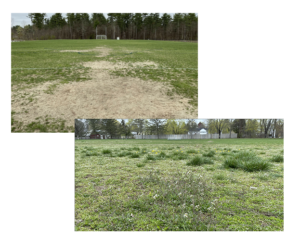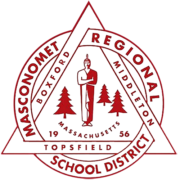In order to continue on with only natural grass fields at Masconomet High School and not install synthetic turf, Masconomet Regional School District would need to implement an expansion, replacement, rehabilitation and maintenance program that is significantly more comprehensive than what we currently budget for in both money, time, resources and land.
Masconomet fields require not just an upgrade, but also an expansion to provide safe field conditions that can handle the constant usage and traffic demands of the student population. In addition to the fields, auxiliary facilities also require renovation or construction to meet the standards of both Americans with Disabilities Act compliance and Massachusetts Interscholastic Athletic Association host guidelines.
As the cornerstone of the Tri-towns – the facility that services all three towns and serves as our public school education for grades 7-12 – Masconomet should be able to provide fields for not only High School athletics, but also youth and adult sports to utilize for overflow, showcase or camp purposes.
GRASS FIELD REST
Grass fields require rest – lower traffic/periods of inactivity. Even with new sod (which requires rest to grow roots before usage), the lifespan is significantly lessened without rest periods and proper maintenance, therefore full replacement must occur more frequently. Current Masconomet fields are used for both practice and games. This is contributing to the deterioration of the existing fields. The Tri-towns do not have enough operational grass fields to support Masco overflow practices to lessen the burden on game fields. This is evidenced by the poor conditions of the grass field at Boxford Commons, Pyebrook and Klock Park.
MULTI-SPORT USAGE
Different sports require different field sizes, and there are issues with the constant shuffling of sports on the same grass fields. For instance, a well-worn sideline for football is considered fair play for soccer. If soccer is played on a grass football field, players are forced to play in the football sideline area where most of the grass has been worn away. The current stadium field is not level enough and includes too many divots for field hockey competition. Grass football fields cannot serve as grass soccer or field hockey fields.
In September 2021, a significant injury occurred in girls soccer when an athlete fell on a broken sprinkler head from an irrigation system. This caused field closure for the rest of that season. By the end of September 2022, Masconomet had two unplayable fields, forcing fall teams to double up both practice and games on existing fields.
GRASS FIELD EXPANSION
In order to maintain all-grass field facilities, Masconomet would need to expand the current footprint of playable space on the existing campus and secure additional land off campus. Much of this has been laid out in the current Stantec study with the creation of a new, additional stadium field on the opposite side of the high school as well as reconfiguring the existing field space. More work would need to be done to identify all possible campus space and identifying new space.
If grass field expansion, reconstruction/rehabilitation was the only concern, Masconomet Regional School District would have to request funds via the capital plan, issuing debt, utilizing free cash or an override. However, there are additional concerns as it relates to amenities, auxiliary facilities, and climate impact.
RELATED FIELD AMENITIES & AUXILIARY BUILDINGS
Our related amenities/auxiliary buildings are not up to current standards, preventing us from hosting fall MIAA tournament games. In addition to a regulation-sized field with the proper width for soccer and a completely level, divot-free field for field hockey, there is also requirement for seating (and accessible seating), restrooms, power for lighting, scoreboards and a Public Address system. Masconomet cannot rely on Boxford Common for MIAA games. While it provides a wide enough and level field, it does not have restrooms or electricity for scoreboards, PA system or lighting.
“THE NFL WANTS GRASS”
There is much debate about the player safety on grass versus artificial turf and a tremendous amount of press around some NFL teams moving to grass. We do not have the resources to maintain fields at the NFL level. They have separate practice fields and have extensive maintenance teams and an unlimited budget.
“The Cardinals roll out their grass field on a 40-inch-deep tray sitting on 546 steel wheels set in railroad-like tracks so the grass field can get sun when not in use. The Raiders’ new stadium contains a sliding tray that holds natural grass. It takes 72 motors gearing up to move the grass surface into the sunlight on non-game days.”
“It’s quite a process: The stadium’s website says the grass is on a “single 40-inch deep tray measuring 234 feet wide and 403 feet long. Rolling on 546 steel wheels which rest on 13 railroad-like tracks, the field travels the 740 feet inside or out of the stadium in approximately 70 minutes at the push of a button.”
Click here to read about the month long maintenance process for the Super Bowl grass field. The grass took 18 months to prepare and cost the NFL around $800,000. And click here to read about the final result of that grass field.
CLIMATE & WEATHER
Climate and weather play a major role in field readiness and impact our ability to play on our fields as well as to maintain them. This pertains to droughts in the summer which necessitate constant irrigation (counter to current environmental sustainability efforts), wet spring and fall months where fields are unplayable, and late fall frozen fields which result in a harsh, solid playing surface. Grass fields require a longer recovery period between the end of one season and the start of another before they can be played on.
This spring (2023), Masconomet did not play on their own fields until April 6. Prior to that, for preseason, regular season practices and tryouts, all field sports teams utilized Boxford Common or the indoor field house in place of our own outdoor fields. Masconomet High School rented Boxford Common for 16-20 hours/week from the middle of March through the beginning of April. Masconomet athletes have a shorter playing season on their home fields than surrounding schools.
Current Tri-town grass field conditions – April 2023
IF GRASS WAS THE ONLY OPTION
Based on the current conditions of our grass fields and the need for expansion, fields would need to be constructed, replaced or rehabilitated with the implementation of a rigorous in-season and annual maintenance schedule. Timing would have to incorporate the rest period for new sod while still accommodating all the usage demands. Full sod replacement is recommended every 5-10 years based on usage and climate and so expansion would be necessary, not optional.
The current Stantec three-phased design accounts for the creation of one new field, with reconfiguration of 2 baseball and softball fields, and updates to the existing back multi-surface field, the current stadium field and track. Masconomet would likely need to add the additional fields behind the football field (currently used for softball) into one of the three phases to include all usable field space and secure additional off-campus land.
Design, Engineering and Permitting costs would still be necessary to appropriately plan for expansion and reconstruction.
GENERAL COST ESTIMATES
There are additional costs, not outlined here, that are associated with upgrading the amenities and auxiliary buildings that are required to meet the standards of both ADA compliance and MIAA host guidelines.
Field Replacement/Reconstruction: $100-$120K per field (Masconomet listed re-sodding for three fields at $98K per field in their 2023 Capital Needs Summary). The cost of construction, replacement and/or reconstruction varies based on the extent of need.
- Removal of existing grass
- Treating the soil
- Re-grading the surface
- Ensuring positive water drainage
- Installing in ground or pop up irrigation system (including winterizing pipes to withstand the cold)
- Replacing existing sod
- Allowing for root growth period (estimates between 2-6 months depending on studies)
Field Maintenance: Estimates to maintain grass fields range from $4K – $15K per field per year. They are variable based on the ability to purchase/maintain the necessary machinery for mowing, slice seeding and aeration as well as irrigation systems (this would need to be accounted for as additional capital expense). Also, there are itemized materials such as fertilizers/pest control. There are additional water costs specific to fields only versus the entire facility. In almost all research, more staff hours are required to perform the maintenance.
- Mowing 2X weekly to keep grass at optimal length and to reduce clumps that block sunlight and become tripping hazards
- Fertilization plans that promote growth based on climate and type of grass, determined by bi-annual soil testing (with environmental compliance)
- Aeration 4-8 times during the season
- Overseeding/slice seeding
- Irrigation
- Controlling pests (weeds, insects, and disease)
- Committing to annual renovation program to assess and address issues
Field Usage Cost: One metric that has not been discussed as much as installation and maintenance costs is the actual field usage cost. Field usage cost of natural grass is twice that of artificial turf. While installation of natural grass is less, maintenance is doubled. When the overall costs are divided by the number of playable hours, the cost of usage per hour is double for grass than turf.
Additionally, grass fields are typically not available for rental as they require rest on off-hours and off-season, so rental income is significantly lower than that of turf which can be used for more hours for more days of the year.
RESOURCES & CITATIONS
[https://extension.okstate.edu/fact-sheets/turfgrass-management-of-bermudagrass-football-fields.html]
[https://www.sportsfieldmanagement.org/natural-grass-athletic-fields/]
[https://www.sportsfieldmanagement.org/natural-grass-athletic-fields/]
[https://www.lawnstarter.com/blog/lawn-care-2/turf-at-nfl-stadiums/]
[https://www.cbsnews.com/boston/news/nfl-shows-wastes-800-thousand-slippery-field-super-bowl/]





